Are you interested in using math, statistics, or computer modeling to address real-world problems? Problems like determining the optimal placement of Tesla charging stations in the US, designing a toll highway to optimize traffic flow, or analyzing data from a company’s online product reviews to best inform their future sales strategies? Then maybe mathematical modeling is for you!
The 2022 MCM/ICM competition will take place February 17-21. Participation is free and on-campus. If you would like to participate or to learn more about this competition, please email b.collins@bucknell.edu. More details and previous problems can also be found at https://www.comap.com/undergraduate/contests/
Author: pm040
Graduate School information session : 4pm Thursday 1/20, OLIN 372
The Graduate Statistics Program at Penn State.
This is a chance to hear about that program and to ask more general questions about graduate school.
All are welcome
INVITED SPEAKER:
David Hunter – Professor of Statistics
Penn State University
THURSDAY – January 20
4:00 – 5:00 PM
OLIN 372
Like challenging math problems? Take the Putnam!
The Putnam Competition is a famous mathematics contest for undergraduates studying in the U.S. and Canada which has taken place annually since 1927. Bucknell students have had some terrific performances in recent years. This year, the competition takes place on Saturday, December 4, and everyone who likes challenging math problems is encouraged to participate. No advanced mathematical knowledge is required, just creative problem-solving. Participation is free and on-campus.
Please contact peter.mcnamara@bucknell.edu if you are interested in participating or have questions.
Winners of the Mathy Art Contest
We had a wonderful and varied collection of submissions! Every attendee of the exhibit was given the chance to vote on their favorites in various categories. Every submission was picked to be the favorite of at least one person, and the voting was very close in most categories. The submissions receiving the most votes in each category are listed below.
Grand Math-erpiece: Word Mandala, by Nancy Cleaver
This entry also won the Most Thought-Provoking category.
Word Mandalas are my explorations of integrating verbal and visual qualities of an idea into one expression.
All the lines form letters, joining one another in sectors of the circle.
In some mandalas, the letters become “grout” lines surrounding the colorful “mosaic” spaces between them. The letters organize the mandalas, then fade into the whole design.
A mandala (mahn-doll’-ah) is “an integrated structure organized around a unifying center”. Every circle, spiral, or sphere is a mandala; so are atoms, cells, planets and their orbits, and many plant structures. We use mandala forms in math, music, literature, religion, and visual arts. Once you begin looking for mandalas, you see and experience them everywhere.
If you would like to search for the word, relax into the image, and let the letters appear, not necessarily from left to right. You will be engaging your whole brain this way. Some are easier to find than others, and of course, you can simply enjoy the work visually.
Nancy Cleaver
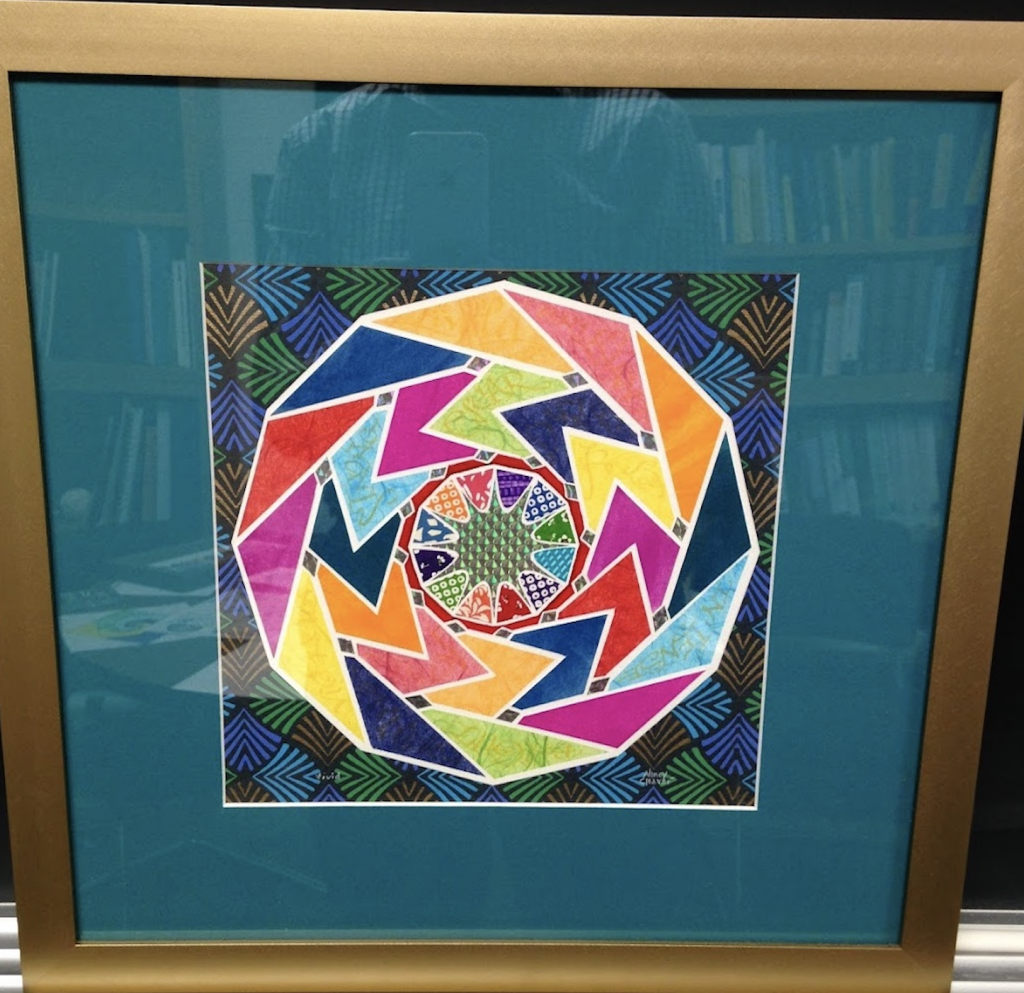
Best Children’s: Adele McNamara, aged 10
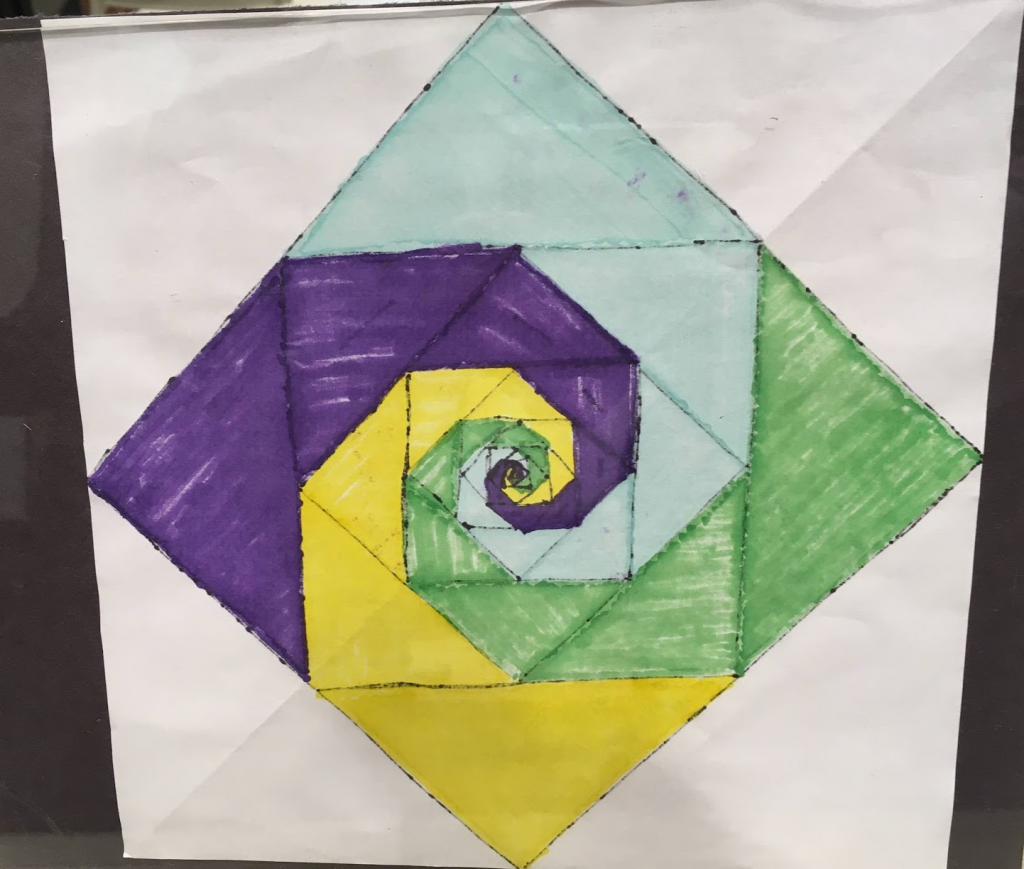
Best Bucknell Student Entry (tied): Miriam Vollmayr-Lee and Peter (Tianzhu) Liu ’22
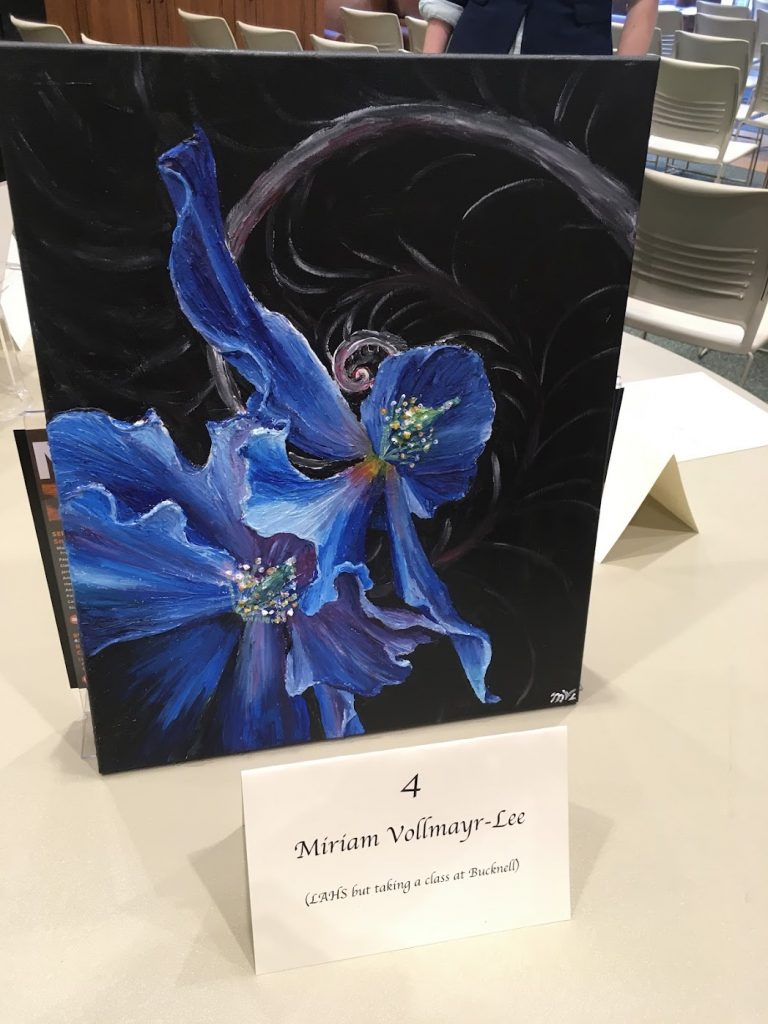
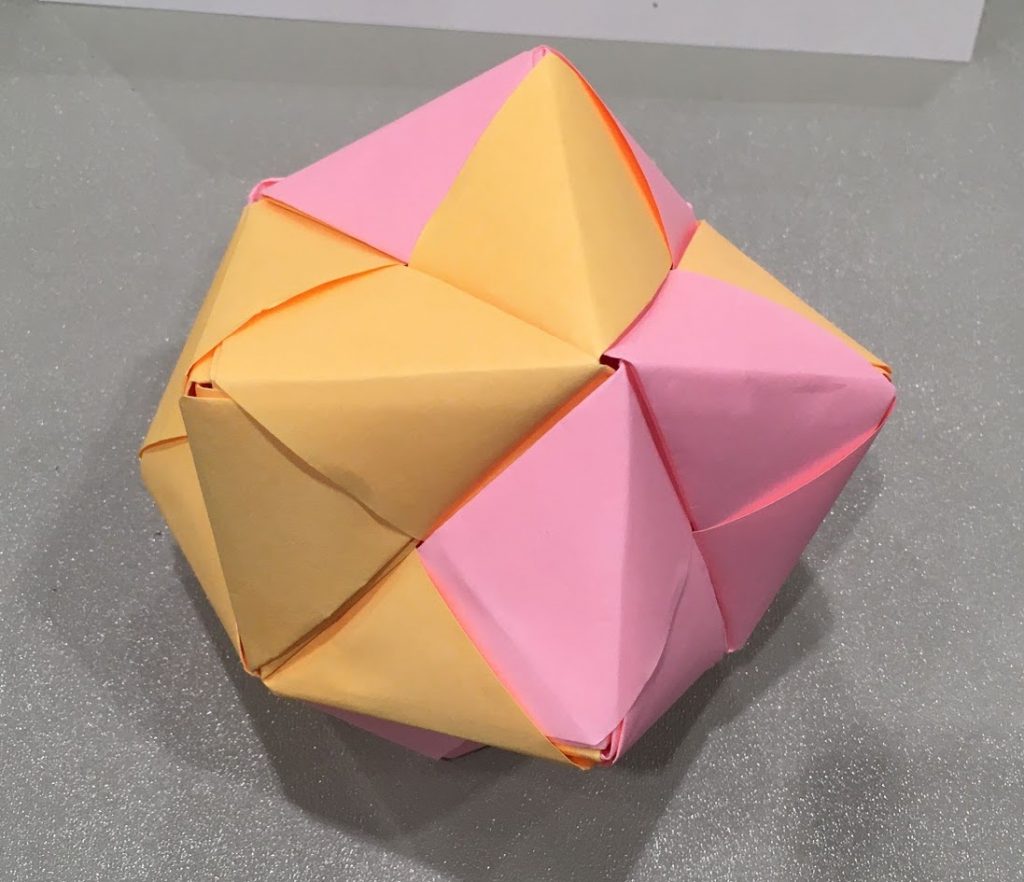
Mathematically Most Intriguing: Yang Hong ’23
Graphitization of the decimal form of π (up to 100000 digits after the decimal point).
The algorithm: each digit is transferred to a unit vector with a direction from 0π/5 to 9π/5. The color is representing the relative position (starting from red and ending at magenta in the sequence of rainbow color), and also making them artful.
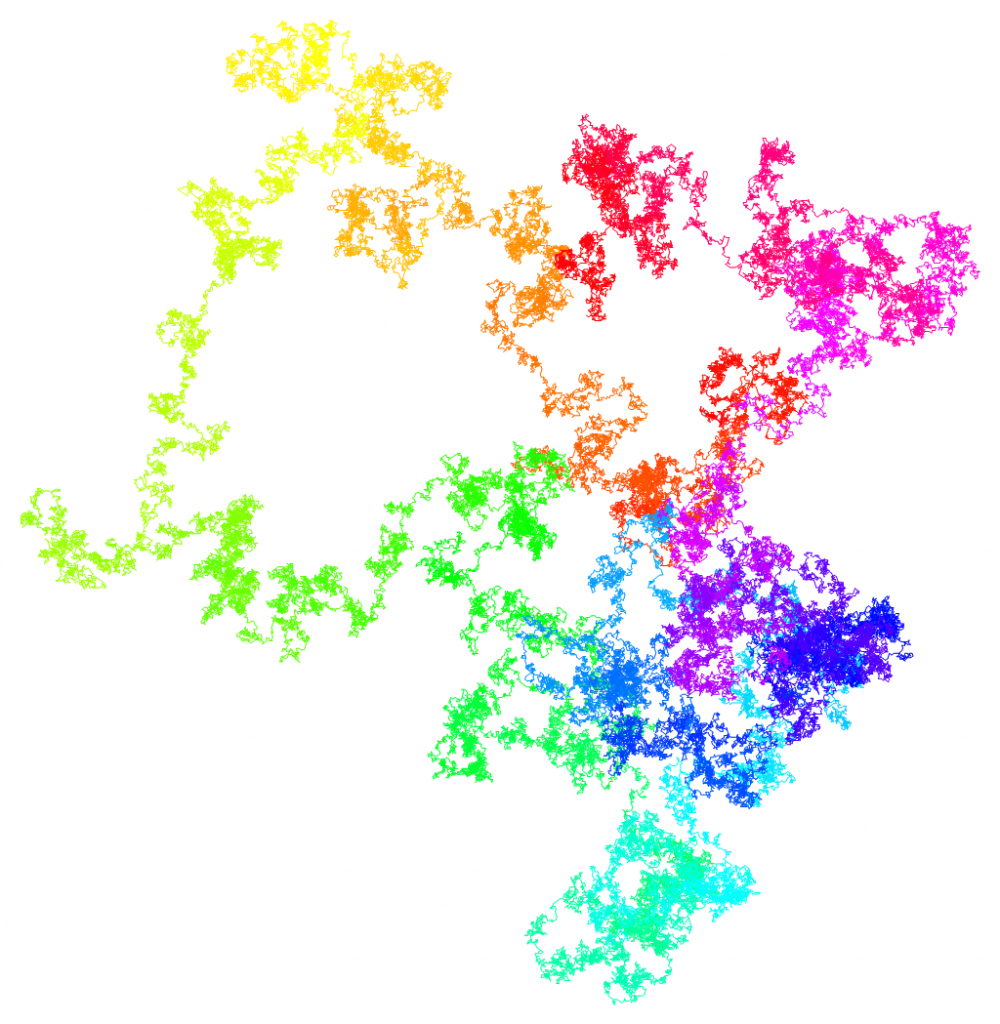
Most attractive: Erica Merriett
Blackwork Embroidery
Pattern: “Just Birds” by Clare Ardali (peppermintpurple.com)
Blackwork embroidery is recognized by its geometric designs that often using repeating floral, star and lattice patterns to fill the inside of a larger shape. While traditional blackwork involves a black thread being stitched onto a white linen or cotton (which may or may not feature accent colors or tones), today the term “blackwork” is more commonly used to describe the technique rather than the use of black thread – so it still uses the delicate geometric designs, but can be stitched in any color.
Blackwork dates back to before the 16th century, and was popularized in England by Henry VII’s first wife, Catherine of Aragon, who brought blackwork clothing with her from Spain. This is why it is sometimes known as Spanish blackwork.
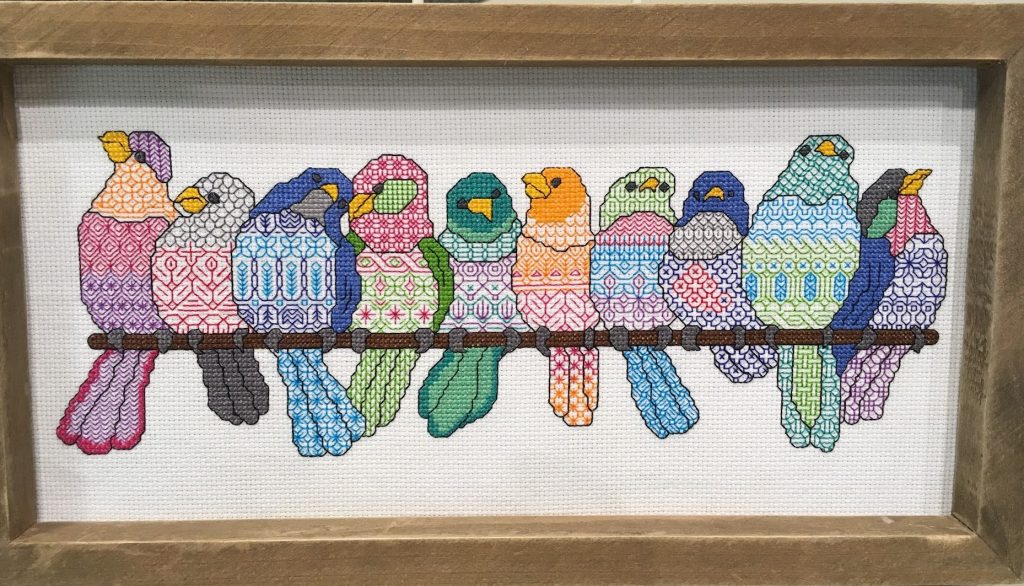
Most Fun: Jiawen (Jessica) Zhao ’22

Mathy Art Contest Exhibit and Voting
Come enjoy the entries to the Mathy Art Contest and vote on your favorite in several categories!
Thursday 10/21 at 11:30am-noon and 1:10-1:40pm.
Great Room, Hildreth-Mirza Hall.
All are welcome.
This event is held in conjunction with the 12:10-1:10 talk in the same location:
“I Can’t Believe it’s (Knot) Math: Invariants and the Kauffman X Polynomial”
by Prof. Zach Cline.
Staying/Coming early for the talk is optional but encouraged
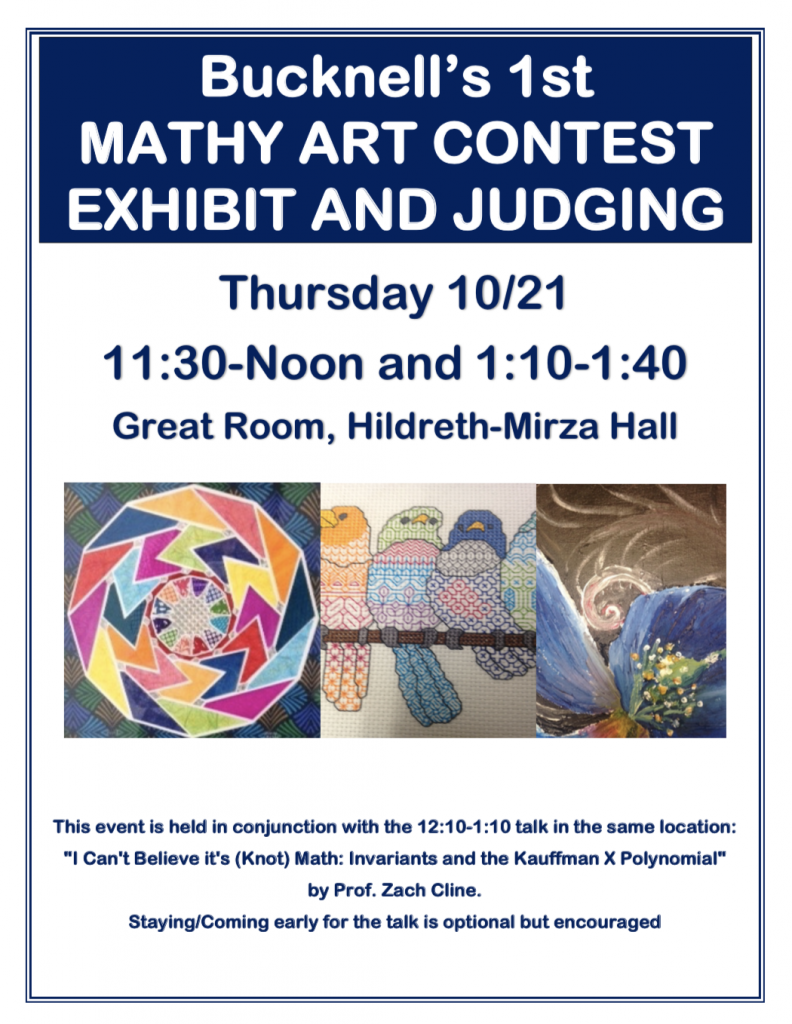
Mathematics Alumni Panel: 9/30 at 12:10pm in Dana 113
Pizza will served at 11:40
MATHEMATICS ALUMNI PANEL
Hear advice and perspectives from Bucknell alumni who will reflect on the value of their mathematics degree and speak about their various career paths. The conversation will include a question and answer period and an opportunity to meet and network with the panelists.
“What Makes Neural Networks So Expressive, and What Could Make Them Smaller,” 12:10 on 9/16 in Holmes 116
Presented by
Thiago Serra
Department of Analytics and Operations Management
School of Management – Bucknell University
Thursday, September 16
Abstract: Neural networks have been successfully applied to complex predictive modeling tasks in areas such as computer vision and natural language processing. On the one hand, they have been shown to be a very powerful mathematical modeling tool. On the other hand, we may still need an unreasonably large neural network in order to obtain a predictive model with good accuracy in many cases. How can we reconcile those two facts?
Pizza served at 11:40 in terrace Holmes 327.
Mathy Art Contest
Bucknell’s 1st Mathy Art Contest. Mathematics and art go together like chips and salsa, Beyoncé and Jay-Z, and orange and blue. If you agree, enter this contest! If you disagree, let us prove you wrong!
• All forms of art welcome including drawing, painting, coloring, sculpture, origami, poetry, creative writing, and the performing arts.
• Only requirement: your submission has some mathematical element, anything from a simple pattern to an Escher-esque hyperbolic plane.
• All members of the broader Bucknell community are welcome to contribute, including local residents, children of Bucknellians, etc.
• Winners in various categories will be by popular vote of the community at a future event. Prizes: eiπ+1 plus great acclaim.
• Deadline: Labor Day, September 6. Send your submissions to peter.mcnamara@bucknell.edu or drop off in Olin 380.
Poster: http://www.unix.bucknell.edu/~pm040/mathy-art-contest-poster.pdf
“Not a Normal Math Talk” at 12:30 on 10/1 via Zoom
https://bucknell.zoom.us/j/95413936042
Student Colloquium Talk by Professor Michael Reeks.
Abstract:
Anyone who has ever shoved a pair of headphones in their pocket knows about the following general principle of the universe:”Any flexible strand will tie itself in knots as soon as it’s given the opportunity.” As such, knots are ubiquitous in nature and art:
– DNA strands, so often pictured as tidy helices, actually spend most of their time hopelessly knotted;
– the way in which proteins interact and function depends heavily on the way they are folded, or knotted, together;
– and some of the oldest known art is based on complex patterns of knots.
Mathematicians, always ready to help out, have therefore tried to study and classify knots for decades. In this sadly pizza-less talk, I’ll introduce the mathematical theory of knots and knot invariants, which are tools that can help us tell knots apart. I’ll explain how some basic questions in knot theory tie into sophisticated topics of current research, and explain a few fascinating ways in which knots arise in chemistry, biology, physics, and art.
Flyer: https://tinyurl.com/y4fwvzjh
Video (Bucknell login required): https://mediaspace.bucknell.edu/channel/Mathematics%2BDepartment/184494973